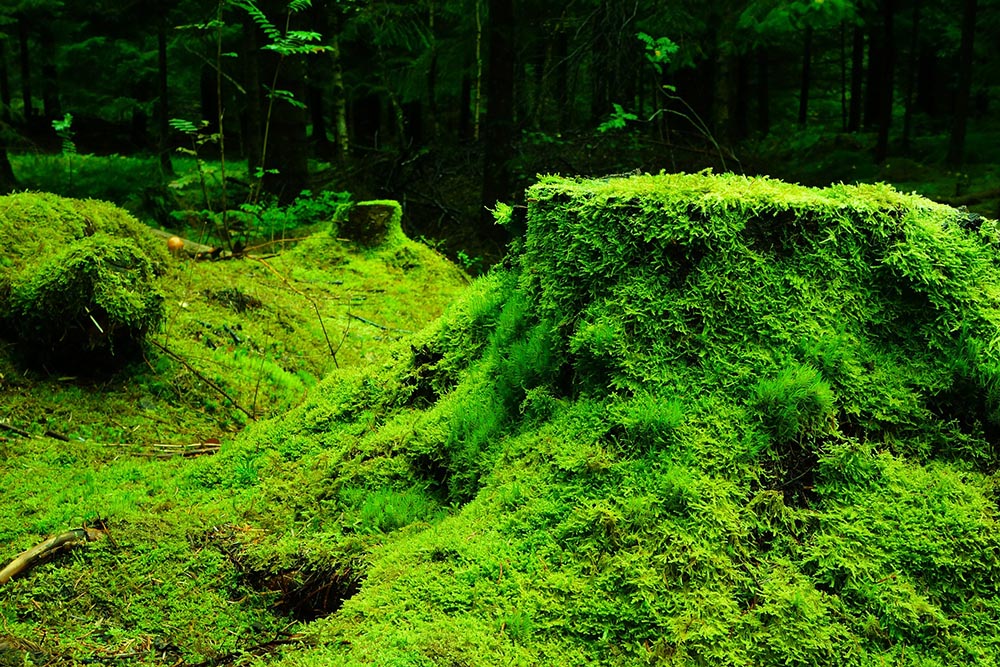
An activist, landscaper, and author, Annie Martin of Pisgah Forest has been covered nationally for her commitment to cultivating native-moss gardens. Photo by Tim Robison
Plant species bryophyta, more commonly known as simple moss, is usually dismissed or destroyed when it crops up in the natural landscape. But radical gardener Annie Martin, popularly known as “Mossin’ Annie,” is impossible to overlook — and her own presence keeps growing.
An old adage says “a rolling stone gathers no moss,” but that clearly doesn’t apply to Martin, who sticks to her mission with a mountain woman’s classic tenacity. After studying sociology at UNC-Charlotte, Martin worked as a TV producer and created publications at Brevard College. It wasn’t until 2008 that the Western North Carolina native began her own eco-friendly moss-based landscaping and design business (after years of research).
Very soon, though, she sought to reach a wider audience with whom the self-described “Georgia Peach” — by way of Buncombe — could preach the gospel of her favorite form of plant life. In her gravelly drawl, Martin educates gardeners about the different kinds of moss, praises the plant’s easy maintenance, and is locally famous for visiting construction sites and rescuing stands of moss from the bulldozer — and transplanting them into gardens.
It’s not as dramatic as it sounds, since she usually has permission. But viewed as a cultivar of the reduce/recycle/re-use culture, her M.O. is decidedly progressive. She’s fiercely loyal to native mountain moss, and offers this warning: “The most dastardly weeds of all, Irish moss and Scotch moss, are not mosses at all. Anything that has a root, flower, or a seed are not true mosses. Spanish moss is, ironically, in the pineapple family.”
As a landscape designer, she knows what moss looks like during different stages of development. “So I can plan for brilliant crimson and gold and copper, jewels sparkling, particularly when the spore capsule is surrounded by a rain drop,” Martin muses scientifically during a recent tour of her home moss garden in Pisgah Forest.
Photos of her near-ubiquitous purple attire also attest to her love of color. And her colorful personality has been covered everywhere from Modern Farmer to The New York Times.
“I’ve been called a lot of things over the years,” she says with a gleam in her eye. “If someone wants to call me the ‘moss boss,’ that’s so funny — but I’m fine with it. Some people already knew me as ‘Purple Annie’ because that’s my favorite color, but I’ll also go by Mossin’ Annie because those are the things in life I love.”
When she moved to her current home, the area in front was a simple paved asphalt patch. That would not do, so she arranged for a massive mound of the ugliest dirt she could buy to be delivered to her home and dumped in the driveway. After rolling over it with her mother’s Subaru, she rid the remains of her front yard of grass and began to cultivate her very own moss garden. That space has since been immortalized in her book The Magical World of Moss Gardening (Timber Press, 2015), and often serves as the natural set for digital-gardening enthusiasts to enjoy via YouTube videos.
“It was an honor to be in the gardening section of The New York Times,” Martin remarks as she pulls herself away from her favorite ground-based natural artifacts. For her, though, the cream of the crop is the prestigious Philadelphia Flower Show, happening early this month.
“My personal and professional goals are to create moss gardens, and I hope there will be someone in the audience who will embrace that concept.”
Later in March, she’s back in her home state for some important regional events. A hybrid of Martha Stewart and Tammy Wynette for the patio set, the restless, bright-eyed Martin is a character best experienced live. But the happily offered some tips to Bold Life readers, as well.
A Q&A with Mossin’ Annie
Why moss?
With mosses, you can blend it into a natural landscape and give a sense of antiquity and purpose into a brand-new landscape. They look great in between the stone cracks of a patio. It gives a touch of nature’s own beauty and elegance.
Talk about your “Three Ws of Moss Care”
Water and walk on your moss. The third “W” is weed. If you follow those guidelines, you can be a successful moss gardener. I learned that out of necessity.
That’s it?
All a moss needs to eat is dust from the air. You don’t need to fertilize it. They taste bad, so garden pests don’t eat it or destroy it, but it creates a habitat for those critters. I found out that all kinds of bees love to come sit in a moss garden and transfer the water back to the hive. I thought they were just coming by to chill out.
And to those who think all moss looks alike?
At one point, I had 50 different species of moss living in my garden, but I have done my experiments and it is still my yard. That’s what makes it even more magical to me. I had to do more than a decade of research to develop this expertise, but to come out and see this on a winter morning makes it all worth it.
Mossin’ Annie will be at Asheville Organic Growers School in Asheville on March 12 and 13 (organicgrowersschool.org) and at the Asheville Outdoor Living Expo on April 24 at 2pm at the WNC Agricultural Center, ashevilleoutdoorliving.com (sponsored by Bold Life’s sister publication Carolina Home + Garden).



